
What Raw Materials Can Be Used?
Typically, the most common types of metals that are being spun in our shop are aluminum, stainless steel, and mild steel. Without getting into the deep specifics, different metals have different properties, so the preferred metal for cones and domes depends on the application of the part. Mild steel tends to be more cost-effective, but it is prone to rust under certain weather conditions. Aluminum won’t rust, but it is a much softer metal when compared with stainless steel.
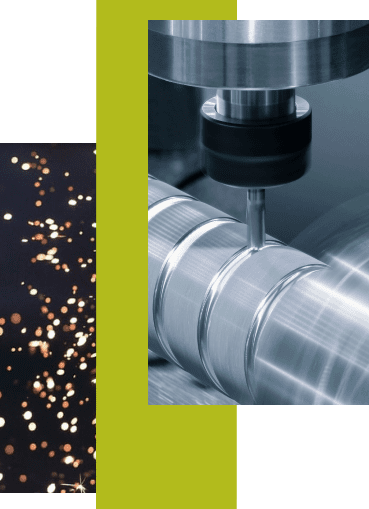
What Sizes Can Be Achieved?
This group about speciality shapes have almost identical spinning capabilities as the first group about the conical and dome shapes. Of course, the shapes and geometries are different, but the biggest OD being spun and material thickness limitations are the same as the conical and dome-shaped sections. Our maximum blank diameter for spinning is still 102”.
Instead of repeating the capabilities, here are some differences:
The Venturi effect is essentially the reduction in fluid pressure that occurs when a fluid/gas (i.e. air) flows through a choked (or constricted) pipe—usually used in HVAC.
Can be composed of a wide range of materials, including aluminum and galvanized steel, which have corrosion-resistant properties.
Parabolic reflectors are used to gather light in telescopes and solar furnaces, and they can also project a beam of light in flashlights, searchlights, stage spotlights, and car headlights.
In radio, they’re used to radiate a narrow beam of radio waves in satellite dishes.
They may also be used in lighting fixtures.
Tapered cylinders are different from cylinders, because a cylinder will generally have parallel sides, meaning the diameter stays constant throughout the length of the cylinder. In a tapered cylinder, the cylinder will either have an increase or a decrease in diameter from one end to the other.
Similarly, domes are comparable to the hollow upper half of a sphere, and a tapered dome is a structure that changes in diameter (or radius) as it extends from its base to its top. It results in a more elongated or flattened dome shape depending on the taper.
Elliptical domes resemble the shape of an egg which is typically wider at one end and narrower at the other end. In most cases, the metal spun part will look like the top half of an egg, in simple terms.
The most popular examples include egg-shaped metal parts in certain types of lamps or light fixtures. These can be aesthetically pleasing and also help to diffuse light in a specific way.
Here’s a chart of KRYTON’s metal spinning material thickness capability:
Mild Steel
⅜” (0.375”)
Stainless Steel
3/16” (0.1875”) or 7 Gauge
Aluminum
½” (0.5”) – Must Be O-Tempered
Venturi
- The Venturi effect is essentially the reduction in fluid pressure that occurs when a fluid/gas (i.e. air) flows through a choked (or constricted) pipe—usually used in HVAC.
- Can be composed of a wide range of materials, including aluminum and galvanized steel, which have corrosion-resistant properties.
Parabolic Reflector
- Parabolic reflectors are used to gather light in telescopes and solar furnaces, and they can also project a beam of light in flashlights, searchlights, stage spotlights, and car headlights.
- In radio, they’re used to radiate a narrow beam of radio waves in satellite dishes.
- They may also be used in lighting fixtures.
Conical (Tapered Cylinders)/Tapered Domes
- Tapered cylinders are different from cylinders, because a cylinder will generally have parallel sides, meaning the diameter stays constant throughout the length of the cylinder. In a tapered cylinder, the cylinder will either have an increase or a decrease in diameter from one end to the other.
- Similarly, domes are comparable to the hollow upper half of a sphere, and a tapered dome is a structure that changes in diameter (or radius) as it extends from its base to its top. It results in a more elongated or flattened dome shape depending on the taper.
Elliptical Dome (Egg Shape)
- Elliptical domes resemble the shape of an egg which is typically wider at one end and narrower at the other end. In most cases, the metal spun part will look like the top half of an egg, in simple terms.
- The most popular examples include egg-shaped metal parts in certain types of lamps or light fixtures. These can be aesthetically pleasing and also help to diffuse light in a specific way.
Thickness
Here’s a chart of KRYTON’s metal spinning material thickness capability:
Mild Steel
⅜” (0.375”)
Stainless Steel
3/16” (0.1875”) or 7 Gauge
Aluminum
½” (0.5”) – Must Be O-Tempered
Quality Control
- Our product quality control process is meticulous and thorough, ensuring the highest standard at every stage of production. Every new part undergoes a quality assurance inspection before every operation.
- For instance, after a flat blank is laser cut, it is immediately checked by our QC team. The same checks are applied after metal spinning the flat blank, trimming, 3D laser cutting, and any other processes that may be applied. This diligent process guarantees that every part meets the customer’s and our exacting standards before it leaves our facility.
- Finally, before a part is shipped to the customer, it undergoes one last comprehensive check, ensuring that what reaches our customer is nothing short of perfection.
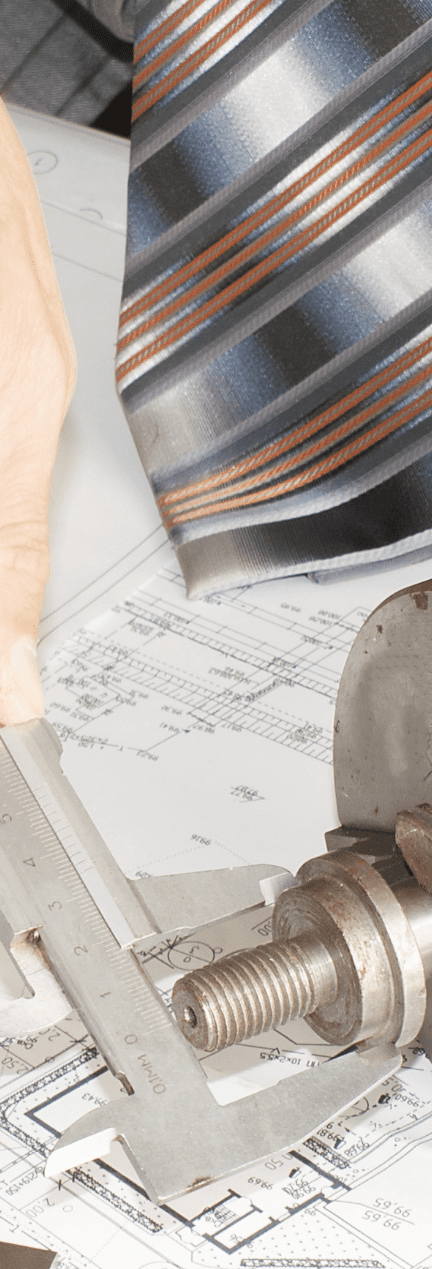
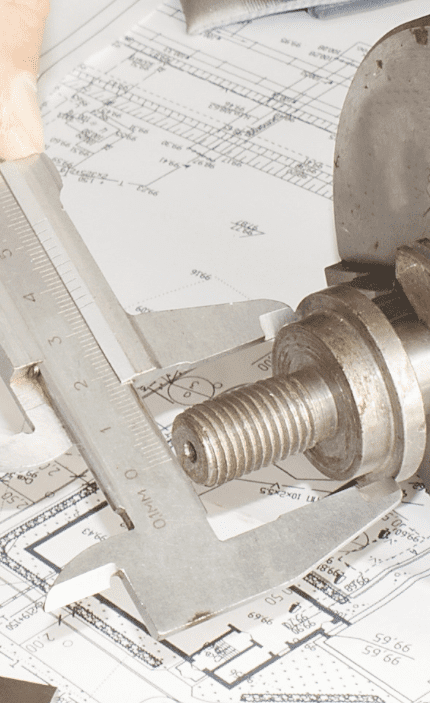
How Does Pricing Work?
Pricing will generally go through the same process that the first three groups went through. The only thing to keep in mind, in general, is that most of these parts will undergo other processes after being spun.
Once a flat blank has been laser-cut, the parts will be spun into the desired shape. Depending on the complexity of the geometry, the parts may get multiple spins. After spinning, to meet a height requirement, the parts may get trimmed in our trim area or our 5-axis laser cutter. On the 5-axis laser cutter, the spun part may also get holes, etch markings, and/or additional cutouts added onto the part.
Besides the laser cutter, the part may undergo a beading process, bending/forming, stamping, welding, polishing, or even assembly, all done inside our one-stop job shop. With appropriate quality checks between every process within new jobs, the parts are meticulously crafted to meet the highest standards of precision and quality. This ensures that every piece delivered from our ship not only meets the specification but also exceeds the customer’s expectation in terms of durability, finish, and overall performance.
Let’s take our stainless steel funnel for example.
The estimators will conclude that the best approach to making a funnel will be to cut a flat blank on our laser cutter, spin the metal into shape, and trim it. For factors that most influence the cost, the estimators will look at using
stainless steel instead of mild steel for better environmental protection, using the appropriate thickness, and reducing operations wherever possible to reduce the quoted price for the customer.
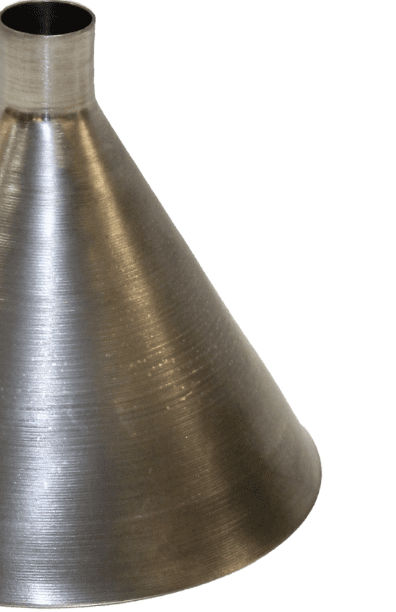
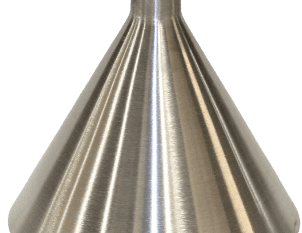
Wrapping Up
If you’re interested in learning more about our services, wanting a deeper understanding of our capabilities, or simply obtaining a quote for your project, don’t hesitate to contact our KRYTON team. We’re always ready to turn your ideas into reality with our state-of-the-art metal spinning techniques.






